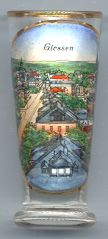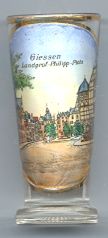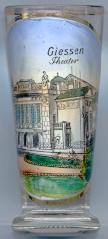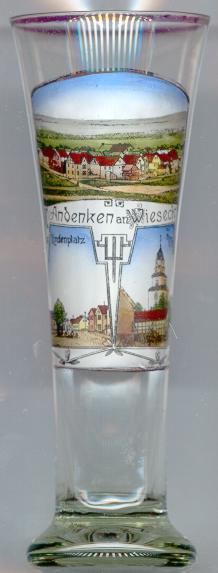

|
| DEUTSCHLAND | GERMANY |
| Bundesland: Hessen | Hesse |
| Regierungsbezirk: Gießen | |
| Landkreis: Gießen |
 Gießen is situated at an elevation of 171 m on the river Lahn, embedded among the foothills of the Vogelsberg, Taunus and Westerwald mountains.
A castle at the mouth of the river Wieseck into the river Lahn (zu den giezzen) was first mentioned in 1150; the earliest mention of the
settlement giezzen dates from 1197. By 1248 Gießen had obtained the status of a town. In 1264/65 it came into possession of the Landgraves of Hesse.
Landgrave Philipp 'the Magnanimous' fortified the town beginning in 1530. The fortifications were torn down by order of Emperor Karl V, but they were rebuilt in 1560–1564.
Gießen became part of Hesse-Marburg in 1567, and then of Hesse-Darmstadt in 1604. The university of Gießen was founded in 1607 as a counterpart to the reformed university of
Marburg by a privilege issued by Emperor Rudolf II. The university was moved back to Marburg in 1624, but
was reopened at Gießen in 1650. Gießen became the seat of the provincial administration of Upper Hesse in 1803. In 1821 it also became the seat of
the provincial government of Upper Hesse within the Grand Duchy of Hesse-Darmstadt.
In 1977 the towns of Gießen and Wetzlar, and 14 other communities
were joined to form the city Stadt Lahn. However, the population of Gießen voted against this merger in a plebiscite two months later.
In 1979 Stadt Lahn was dissolved and Gießen became an independent community again.
Gießen is situated at an elevation of 171 m on the river Lahn, embedded among the foothills of the Vogelsberg, Taunus and Westerwald mountains.
A castle at the mouth of the river Wieseck into the river Lahn (zu den giezzen) was first mentioned in 1150; the earliest mention of the
settlement giezzen dates from 1197. By 1248 Gießen had obtained the status of a town. In 1264/65 it came into possession of the Landgraves of Hesse.
Landgrave Philipp 'the Magnanimous' fortified the town beginning in 1530. The fortifications were torn down by order of Emperor Karl V, but they were rebuilt in 1560–1564.
Gießen became part of Hesse-Marburg in 1567, and then of Hesse-Darmstadt in 1604. The university of Gießen was founded in 1607 as a counterpart to the reformed university of
Marburg by a privilege issued by Emperor Rudolf II. The university was moved back to Marburg in 1624, but
was reopened at Gießen in 1650. Gießen became the seat of the provincial administration of Upper Hesse in 1803. In 1821 it also became the seat of
the provincial government of Upper Hesse within the Grand Duchy of Hesse-Darmstadt.
In 1977 the towns of Gießen and Wetzlar, and 14 other communities
were joined to form the city Stadt Lahn. However, the population of Gießen voted against this merger in a plebiscite two months later.
In 1979 Stadt Lahn was dissolved and Gießen became an independent community again.

Glass no. 1122 [left] shows the square  Landgraf-Philipp-Platz, named for
Landgrave Philipp the Magnanimous (1504–1567). The building on the far right of the glass is the
Landgraf-Philipp-Platz, named for
Landgrave Philipp the Magnanimous (1504–1567). The building on the far right of the glass is the
 New Castle (Neues Schloss), built by Philipp in 1533–1537. It is one of the most important half-timbered
Late Gothic/Early Renaissance residences in Hesse. Today the building is used by the university.
New Castle (Neues Schloss), built by Philipp in 1533–1537. It is one of the most important half-timbered
Late Gothic/Early Renaissance residences in Hesse. Today the building is used by the university.
Two famous scientist were professors at the university of Gießen. Justus LIEBIG (1803–1873), the most important chemist of the 19th century, was professor from 1824 until 1852. In 1948, the university was named Justus-Liebig-Hochschule. It regained the status of a full university (Justus-Liebig-Universität) in 1957. Wilhelm Conrad RöNTGEN (1845–1923), discoverer of the X-rays (in German: Röntgen-Strahlen) and first Nobel Laureate for Physics in 1901, was professor at Gießen from 1879 until 1888.

The  Stadttheater (Municipal Theatre) [left] was built in 1907 according to a design of the famous theatre architects
Hermann Helmer and Ferdinand Fellner. The theatre was partly destroyed during World War II. It was closed in 1944/45, but reopened
already in 1946/47. A thorough renovation in the 1970s emphasized the remaining original parts in Art Nouveau and Neoclassical style.
Stadttheater (Municipal Theatre) [left] was built in 1907 according to a design of the famous theatre architects
Hermann Helmer and Ferdinand Fellner. The theatre was partly destroyed during World War II. It was closed in 1944/45, but reopened
already in 1946/47. A thorough renovation in the 1970s emphasized the remaining original parts in Art Nouveau and Neoclassical style.
(See also list of further buildings by Fellner and Helmer that are depicted on glasses of this collection.)

Wieseck [right], today a part of Gießen, was already mentioned in a document of AD 775, and thus is older than Gießen itself. In the 15th century, the village received its own fortifications of which a mighty gate tower still remains. Wieseck became part of Gießen in 1939.
The  church of St. Michael [bottom right picture] goes back to a church that was already mentioned in 778.
The oldest parts of the present church date from the 13th century. The vaulting and the glass windows of the chancel were created in the 14th century. The windows of
the nave and the portal are from the 15th century.
church of St. Michael [bottom right picture] goes back to a church that was already mentioned in 778.
The oldest parts of the present church date from the 13th century. The vaulting and the glass windows of the chancel were created in the 14th century. The windows of
the nave and the portal are from the 15th century.
The bottom left picture shows the square  Lindenplatz.
Lindenplatz.
![[scale]](lineal.jpg)